Summer can be hard on container gardens in the south. It’s so easy to finally just give up on them, especially when a last end of the season getaway beckons, or you’ve forgotten to water once too many times and the poor plants just look too sad for words. Well, I’m here to tell you it’s ok.
You can forgive yourself for your forgetful plant parenting, because September is the beginning of a new season – we can call it the pre-pansy season, because even though it’s still too early to plant pansies and violas, there are some other options to tide you over until cooler weather finally comes.
I had the opportunity to give a trio of pots just such a makeover the other day. There were actually two – a half planter, a terra cotta pot, and a cast stone pedestal the owners wanted a new planter set on.
Because their pots and pedestal are all of different materials and colors, I chose a simple lightweight black bowl to sit on the pedestal. The size works well with the others and adds a different shape too. I’ve suggested in past posts that wandering the garden shop picking up plants and grouping them together to see how they’ll work together is a great way to design plantings, and that’s just what I did here.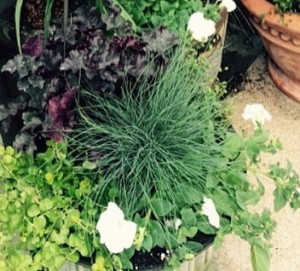
I changed and rearranged them until I was satisfied. It’s important, however, to understand how each plant will grow out in a composition like this since there are “many parts to the whole.”
Here’s what I came up with for this trio of pots. I started with the deep red fountain grass for its beautiful fall color, and I liked how it blended with the dark leaves of the heuchera in each pot. They also show up well against the cream color of the brick.
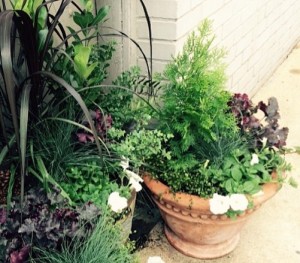 A blue-green fescue adds another, shorter, grass element, contrasting with the smaller, rounder leaves of the trailing angelvine and creeping jenny. White petunias add brightness and will also trail.
A blue-green fescue adds another, shorter, grass element, contrasting with the smaller, rounder leaves of the trailing angelvine and creeping jenny. White petunias add brightness and will also trail.
The red fountain grass is an annual, so it will be pulled out with the onset of cold weather and the bay planted with it will stay. In the terra cotta planter there’s a small arborvitae, and In each pot some elements are repeated so it’s not too chaotic looking…
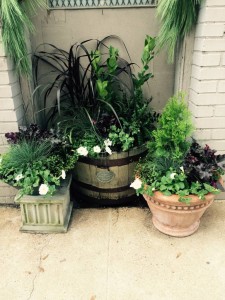 Maintenance will mean consistent watering since the planting will become root bound – in the smaller pots especially, and the petunias will need to be deadheaded to keep them blooming. A few pumpkins and gourds would also look great at the base through the fall…
Maintenance will mean consistent watering since the planting will become root bound – in the smaller pots especially, and the petunias will need to be deadheaded to keep them blooming. A few pumpkins and gourds would also look great at the base through the fall…
With the onset of cooler weather and pansy season, the petunias can be replaced by white (Or a color if they prefer.) pansies or violas. The remainder of the plants are perennial, so can be left through the winter. They’re situated against a wall which should help keep them warm, but it would be smart to protect them with a covering if temps fall below freezing for any length of time.
By Kris Blevons

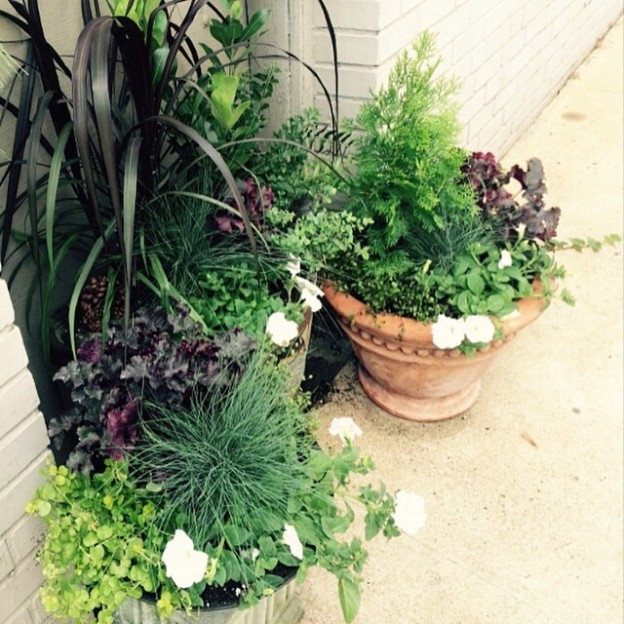
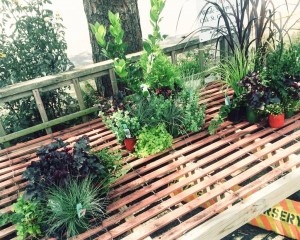

 The temperatures are hopefully trending downward, and you’re thinking about redoing your summer plantings. There seem to be so many choices; it’s normal to feel overwhelmed at the garden shop, even though you probably thought you had it all figured out before you left home!
The temperatures are hopefully trending downward, and you’re thinking about redoing your summer plantings. There seem to be so many choices; it’s normal to feel overwhelmed at the garden shop, even though you probably thought you had it all figured out before you left home!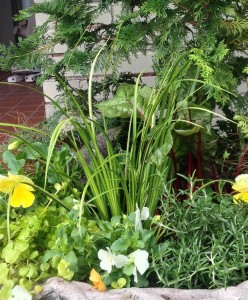 The large planter here is one of a pair, used at the top of stairs leading onto a wide open porch. I took my color cues from the red brick and cream color of the house in choosing my plants, using predominantly yellow with the evergreen Chamaecyparis ‘Crippsii’, yellow variegated Acorus ‘Ogon’, golden creeping Jenny to trail, and Matrix ‘Lemon’ pansies. To this I added ornamental red mustard, and a chard with red stems called ‘Charlotte’. These will add big, bold leaves, beautiful foliage color, and added height.
The large planter here is one of a pair, used at the top of stairs leading onto a wide open porch. I took my color cues from the red brick and cream color of the house in choosing my plants, using predominantly yellow with the evergreen Chamaecyparis ‘Crippsii’, yellow variegated Acorus ‘Ogon’, golden creeping Jenny to trail, and Matrix ‘Lemon’ pansies. To this I added ornamental red mustard, and a chard with red stems called ‘Charlotte’. These will add big, bold leaves, beautiful foliage color, and added height.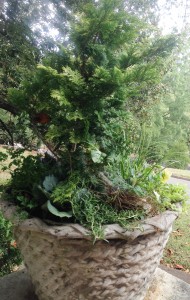 These planters are quite large and can support this variety of plants. In smaller planters, a smaller shrub, some curly parsley, pansies and a trailing plant might be sufficient. Remember, more is always better in planters and windowboxes to give them a lush overflowing feel.These planters will make a definite statement as they grow out.
These planters are quite large and can support this variety of plants. In smaller planters, a smaller shrub, some curly parsley, pansies and a trailing plant might be sufficient. Remember, more is always better in planters and windowboxes to give them a lush overflowing feel.These planters will make a definite statement as they grow out.